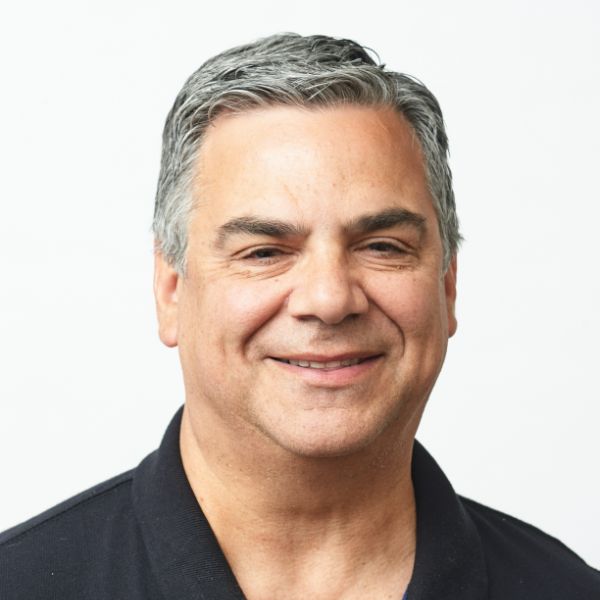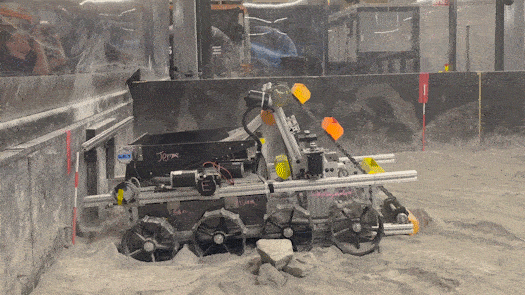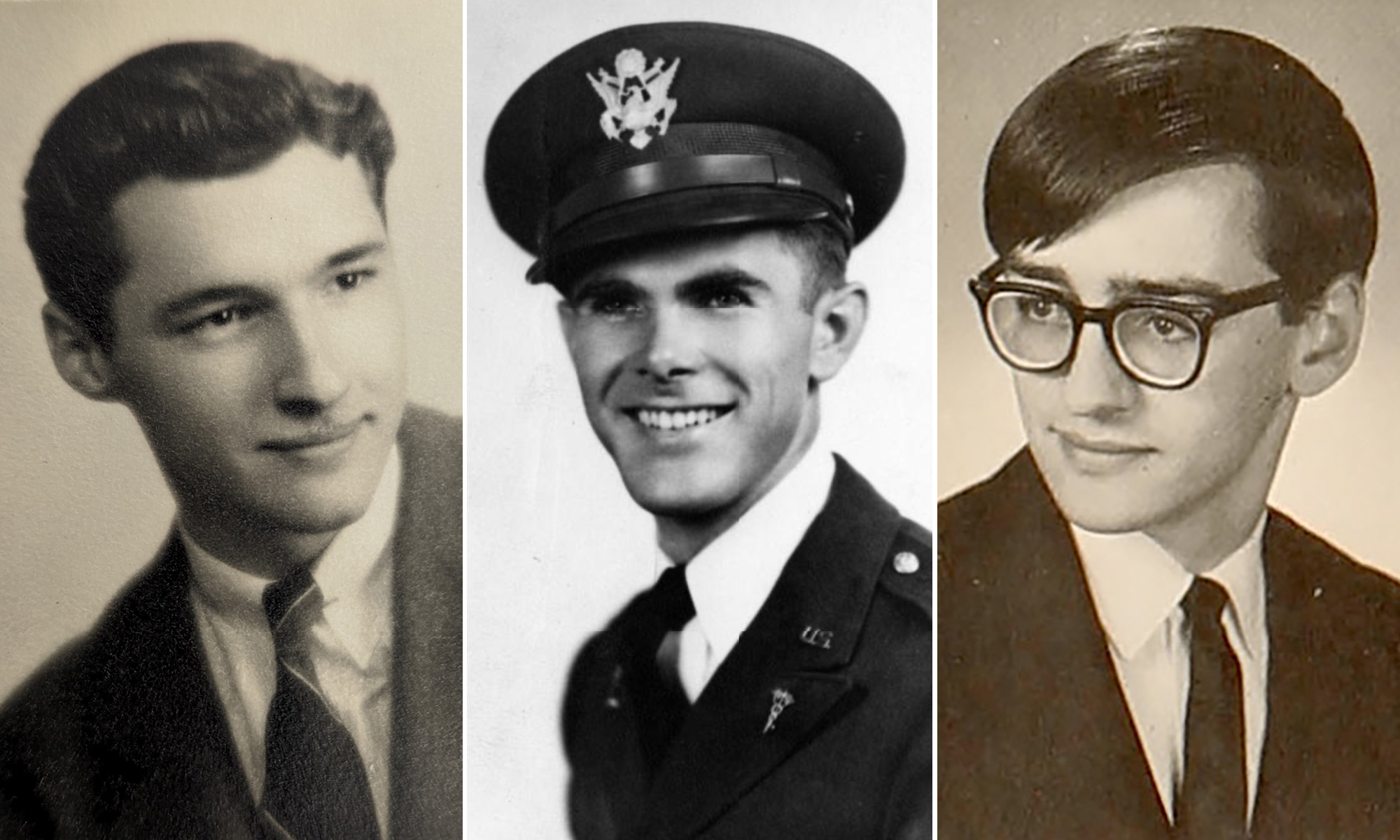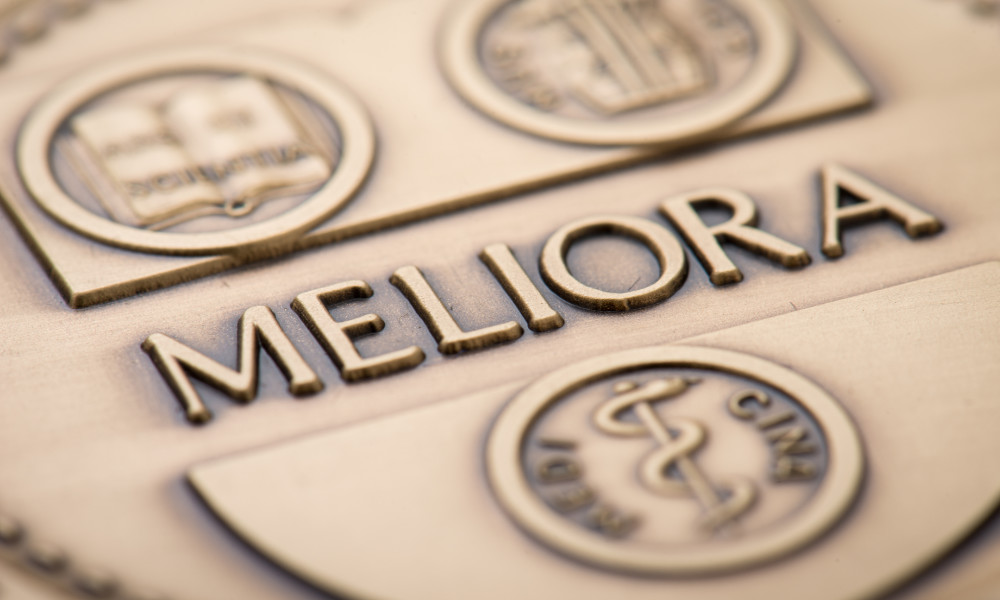The COVID-19 pandemic has changed life for all students at the University of Rochester, including more than 4,700 graduate students who are studying, working, and researching remotely this semester from the University’s seven schools: the Eastman School of Music, the Hajim School of Engineering, the School of Arts & Sciences, Simon Business School, the School of Medicine and Dentistry, the School of Nursing, and the Warner School of Education.
They come from 97 countries, all 50 states, Puerto Rico, and the District of Columbia. Most are in doctoral or master’s programs, while 280 will receive graduate certificates. They’re tomorrow’s musicians, engineers, doctors and nurses, scientists, humanists, entrepreneurs, and teachers.
We first reached out to a group of eight graduate students earlier this year, with the idea of highlighting their lives as scholars and members of the University community. We caught up with them this month to see how their work and lives had been affected by remote learning and working guidelines put in place this spring.
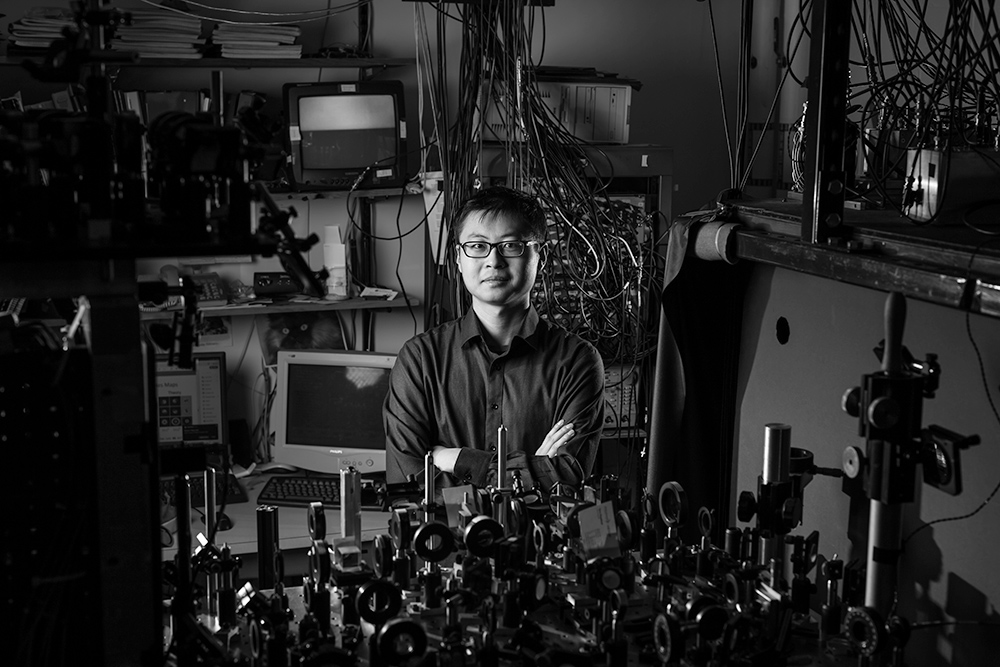
(University of Rochester photo / J. Adam Fenster)
Zekai Chen
School of Arts & Sciences
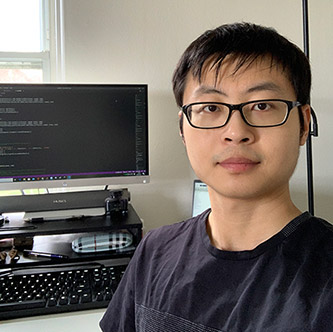
Zekai Chen arrived at the University in 2015 after receiving a bachelor’s degree in electronics and information science from Peking University in his hometown of Beijing, China. He hopes to earn his doctorate in 2022.
“I’ve been here a long time and learned a lot,” Chen says. “I’ve learned how to perform research and have been given maximum freedom and independence to study problems I’m interested in.”
That independence has come in handy since the University went to distance learning in March. Chen is normally based in the Bausch & Lomb Hall lab of Nicholas Bigelow, the Lee A. DuBridge Professor of Physics. Chen works with ultracold atomic gases such as Bose-Einstein Condensate (BEC), and his current research focus is using multiple lasers to create the artificial gauge potential and study the behavior of BEC in those potentials.
“Since I’m currently doing theoretical calculations, I can work from home,” says Chen, who has remained in Rochester. His career goal is “teaching and performing research at a University like Rochester.”
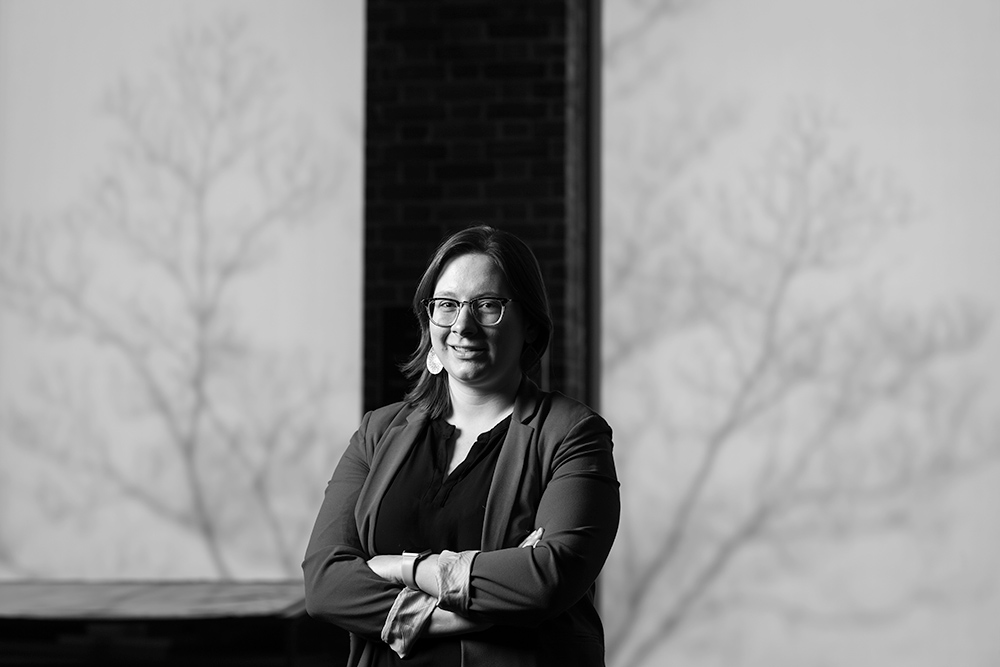
Gabrielle Cornish ’13E, ’16# (MA)
Eastman School of Music
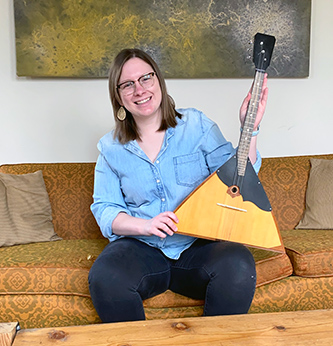
The Elmira, New York, native is a doctoral student in musicology, on track to receive her degree in May. Her research broadly considers music, sound, and everyday life in the Soviet Union from 1956 to 1975, tracing the intersections between music, technology, and the politics of social modernity after Stalinism.
During her time away from the Eastman campus, she has defended her dissertation via Zoom, was hired as an assistant professor of musicology at the University of Miami’s Frost School of Music (she starts this fall) and has supported friends who are teaching remotely. The classically trained percussionist also spends hours in her Rochester apartment playing guitar, as well as balalaika—a lute-like stringed instrument native to late 18th-and early 19th-entury Russia—and theremin—one of the earliest electronic instruments, invented in Russia in 1919. “And like many other anxious millennials these days,” she adds, “I’ve started stress-baking bread.”
Cornish majored in both music and Russian studies as an undergraduate in the College, completed a Fulbright US Student Grant in Chelyabinsk, Russia, and began her doctoral studies at Eastman in 2014.
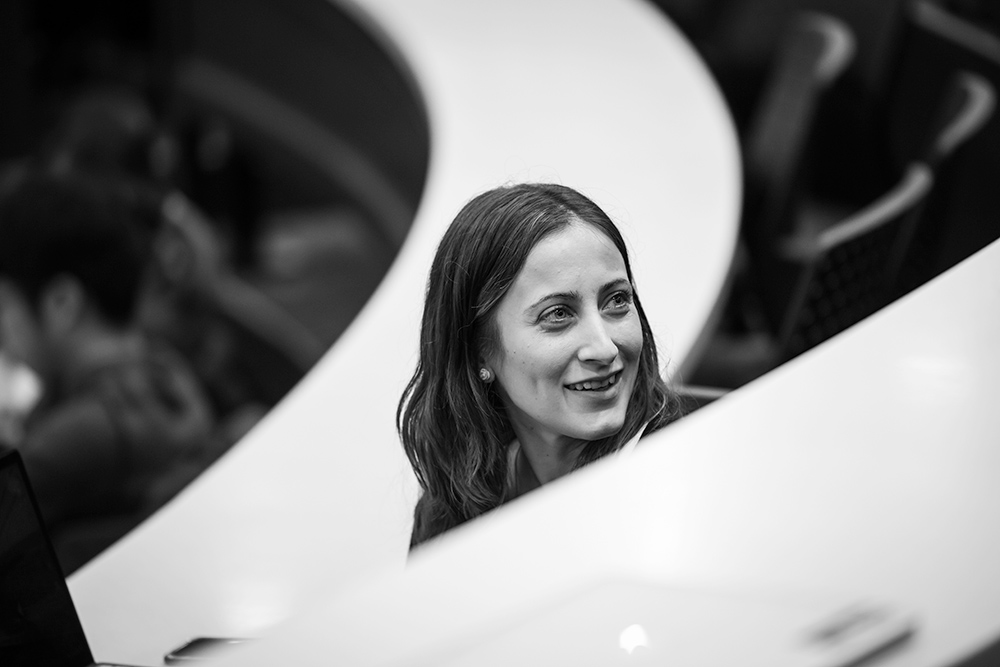
(University of Rochester / J. Adam Fenster)
Daniela Figoli
Simon Business School
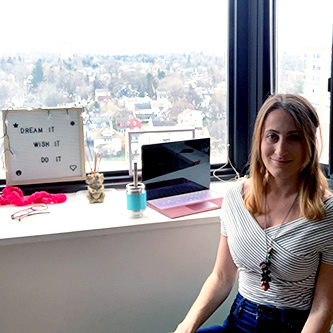
The native of Buenos Aires, Argentina, will graduate in May with an MBA in strategy and pricing. Her classes—and her job at Simon’s Career Management Center—are conducted through Zoom. In her job, she advises fellow graduate students on their job search, networking and interview skills, and resume writing.
“Our professors have really adjusted to this new environment,” she says. “It’s been a learning experience. But even though I prefer presentational classes, I feel I’m getting the same benefits regarding my learning experience, and Simon has done a very good job transitioning into a virtual world. We still have happy hours, coffee hours, and other activities. I’m even giving volunteer yoga Zoom classes!”
Figoli received her undergraduate degree in industrial pharmacy at the University of Buenos Aires, two miles from home. She chose Simon—5,500 miles from home—to improve her analytical skills, acquire business acumen, and pursue her MBA. She hopes to leverage her understanding of customers’ needs to develop market-driven solutions that improve people’s lives.
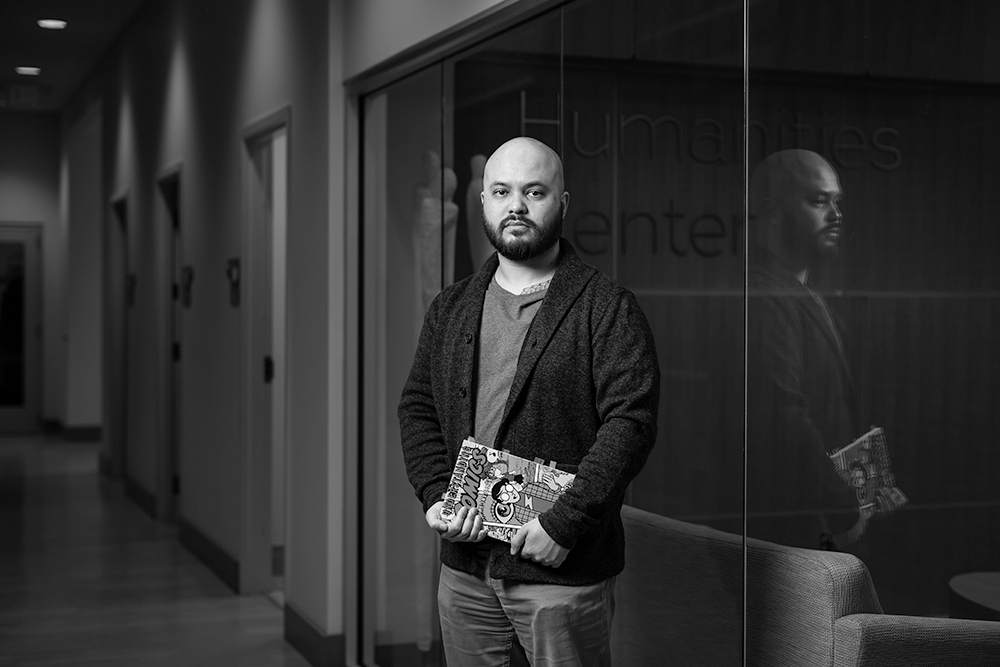
(University of Rochester photo / J. Adam Fenster)
Jamey Keeton
School of Arts & Sciences
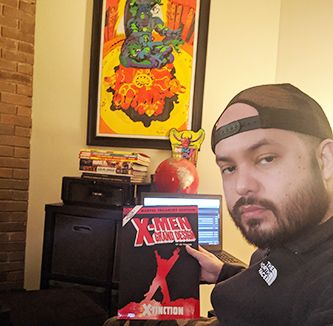
The first-year doctoral student in the Graduate Program in Visual and Cultural Studies program is focused on comics studies, with research interests that include film, television, animation, and popular culture.
The San Diego State graduate has long enjoyed comic books (his favorite era is the 1980s and ‘90s) and cohosted a podcast on the subject a few years ago.
Keeton remains in Rochester but finds remote learning a challenge. “I don’t enjoy working at home because I become distracted very easily,” the San Diego native says. “I had a job lined up this summer but it evaporated (when businesses in New York closed).” He has tried to make the best of this new life, “cooking a lot, reading, playing video games, and watching all sorts of things on TV.”
A Marines infantryman who toured the world from 2007 to 2011, Keeton is taking classes through Zoom. His career goal is to work as a tenured professor at a university.
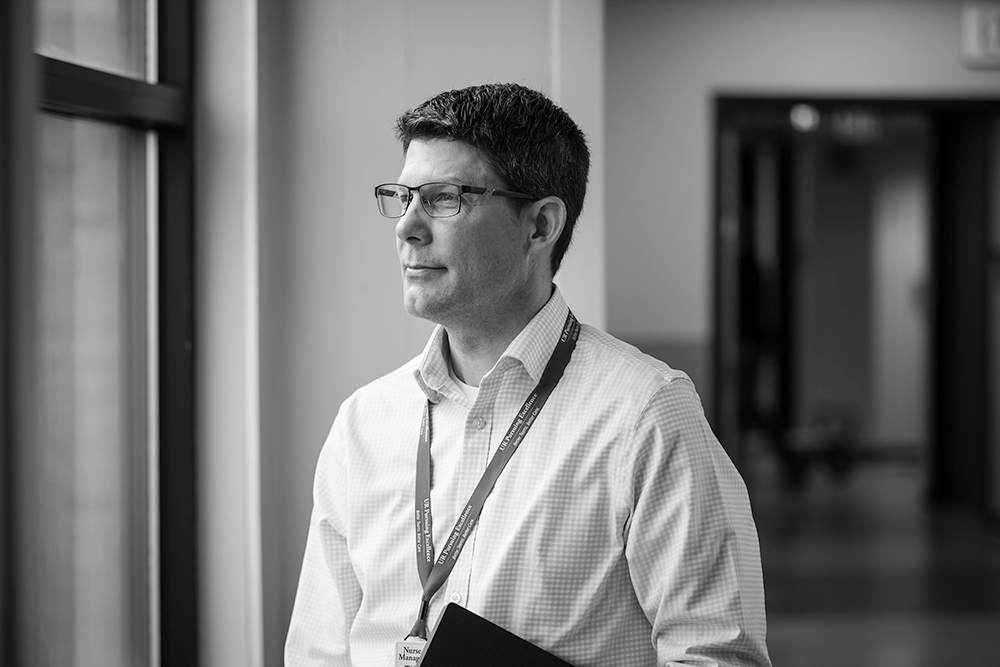
(University of Rochester photo / J. Adam Fenster)
David Lent
School of Nursing
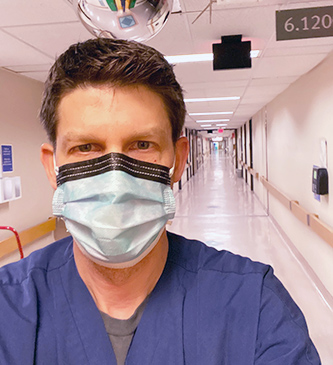
Lent, who is from Penn Yan, New York, will earn his doctor of nursing practice degree in May and is outcomes manager for adult critical care nursing at the Medical Center. His ultimate goal is to lead a nurse innovations lab and work with nurses to develop more efficient strategies to assist patents.
“The pandemic has presented the ideal opportunity for me to apply every bit of my academic, clinical, and systems thinking to prepare our ICU response,” he says. “It’s literally the culmination of all my training coming to a head.”
Since defending his doctoral project in March, Lent has worked 60 to 70 hours per week alongside nursing, physician, and hospital leadership to prepare for the predicted surge in cases. “Everyone is stepping up their game, and we are working together like never before,” he says. “This is truly the year of the nurse.”
Lent entered the School of Nursing in 2010. He earned a master of science degree in health care systems management and leadership (2012), a bachelor of science degree in nursing (2014), and a post-masters certificate as a clinical nurse leader (2017).

Alex Milliken
School of Medicine and Dentistry
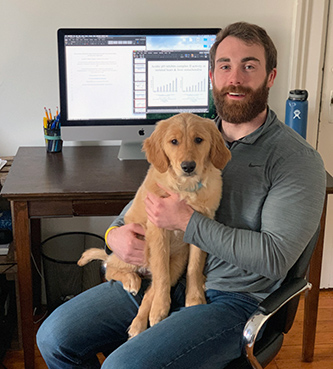
Milliken is a third-year pharmacology student from Hilton, a suburb of Rochester. Since research is on pause at the University, he has kept busy by preparing a manuscript for publication, analyzing data, and writing a grant for a predoctoral fellowship. He also added a golden retriever puppy named Sophie to his home. “This is perfect timing to take care of her, being home so much,” he says.
After receiving undergraduate degrees in biochemistry and molecular biology at Wells College in Aurora, New York, Milliken came home to explore his passions—mitochondria and metabolism. “The University has a very strong mitochondria research group,” he says.
Losing his grandfather and a close friend to cardiac-related deaths sparked his passion for understanding the role of mitochondria in cardiovascular disease.
He’s a member of principal investigator Paul Brookes’ lab, which focuses on the underlying molecular and metabolic mechanisms of heart attacks. His research focuses on how an acidic pH can minimize cardiac tissue damage after a heart attack.
Milliken hopes for a career “fully immersed” in research dealing with mitochondria biology, metabolism, and exercise.
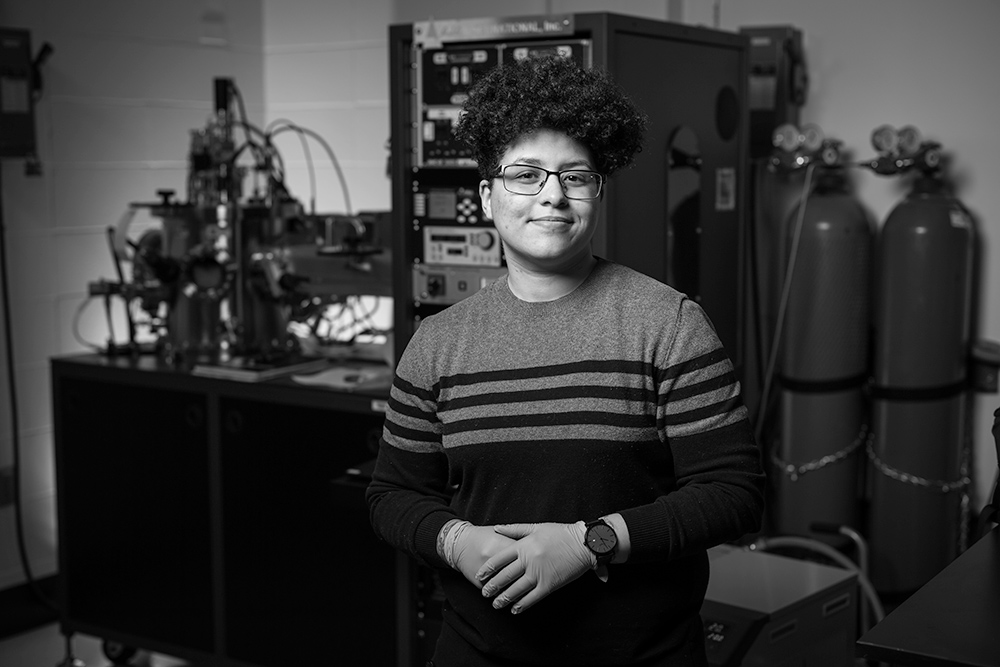
Tara Peña
Hajim School of Engineering & Applied Sciences
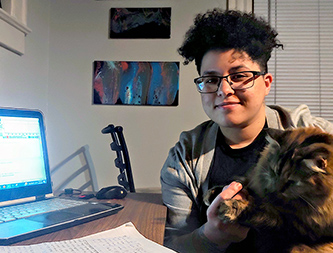
A third-year doctoral student in the Department of Electrical and Computer Engineering, Peña works with professor Stephen Wu in the areas of nanoelectronics, spintronics, and quantum electronics. The first-generation student from Queens, New York, was awarded a Provost’s Fellowship by the University.
Since the campus shut down in March, the lab has moved entirely to data analysis and literature review, and members use Zoom for regular meetings. Peña’s siblings have moved in with her due to the severity of the coronavirus pandemic in New York City.
She received her undergraduate degree in physics from Adelphi University on Long Island and came to Rochester in 2017. “I chose Rochester because of its strong collaboration between its electrical and computer engineering and physics departments—and for the chance to work with Professor Wu,” she says. “It’s been awesome.”
Peña’s research focus is in “developing strain-based nanoelectronics with transition metal dichalcogenides”. Her career goal is to facilitate her own research group.
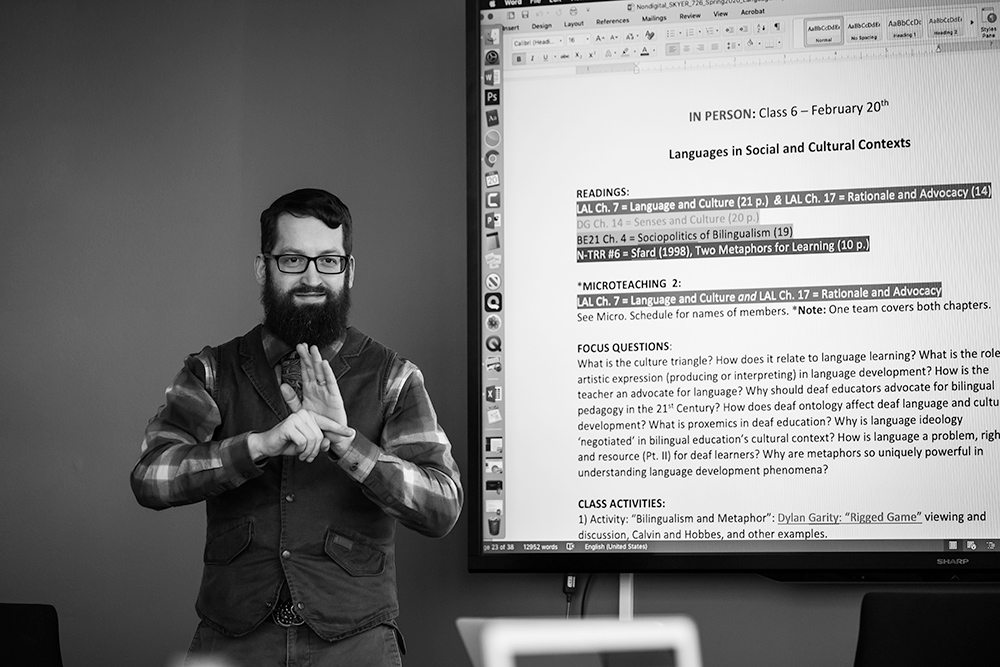
Michael Skyer
Warner School of Education
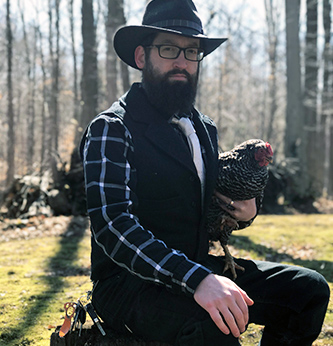
Skyer is a PhD candidate in the Teaching, Curriculum, and Change discipline at Warner, where he has studied since 2012. His work aims to resolve structural problems in deaf education and focuses on the value systems surrounding visual and multimodal pedagogies used in teaching deaf and hard-of-hearing students.
The Rochester native majored in studio arts at Rochester Institute of Technology, then trained to be a deaf educator at RIT’s National Technical Institute for the Deaf. In the MSSE program, he earned a master’s degree in secondary education for students who are deaf or hard of hearing. After several years teaching in K-12 deaf education, he joined NTID’s faculty in 2011—rising from adjunct to senior lecturer.
“Because of my full-time duties, I’m in the half-time plan at Warner,” Skyer says.
Skyer brought home a supply of textbooks, papers, and dissertation data, which he is analyzing with qualitative coding procedures to find patterns in and across data sources such as interviews, teaching documents, and stimulated recall. His NTID classes are now taught remotely, and he created a document called the “Post-COVID-19 Syllabus Amendment,” which streamlines ways in which his graduate students earn participation credit with digital media.
“While teaching with digital tools is fascinating, I miss face-to-face interactions with students and colleagues,” says Skyer, who hopes to earn his doctorate in 2021.
Graduate students by the numbers
There are 4,768 students in graduate programs at the University of Rochester’s seven schools.
280 are pursuing graduate certificates
1,947 are in doctoral programs
2,541 are pursuing master’s degrees
They come from 97 countries (led by China with 1,284) and all 50 states (led by New York with 1,687), plus Puerto Rico and the District of Columbia.
The leading master’s field by enrollment is finance, with 341 students. The top doctoral programs are performance and literature at the Eastman School of Music (108), optics (98), and physics (97).
Age has no boundary among graduate students: 3,022 are 29 and under, and 29 students are between 60 and 74.

